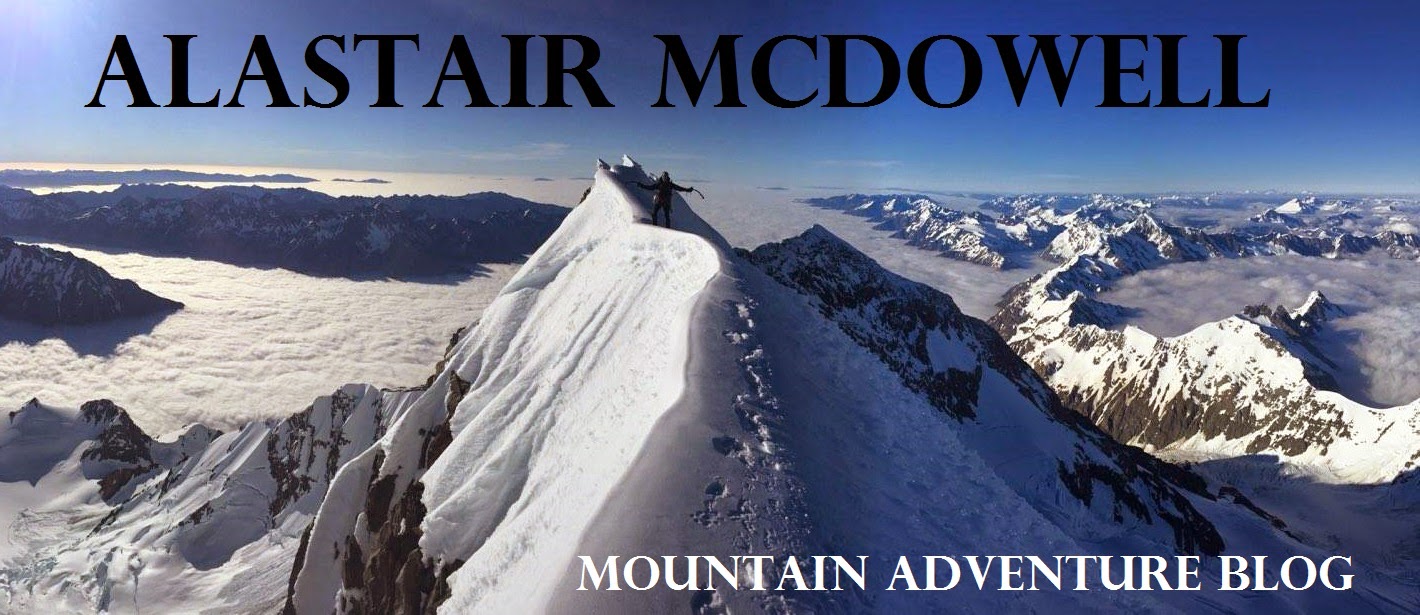Eating a hearty lunch of Tarras loaf and butter at Lindis Pass after being dropped off by an Israeli lady, I didn't rate my chances of the next lift down the hill. The road was narrow and fast. Until I gleaned into conversation with an elderly man, a solo photographer, driving an old motor-home. "Heading that way?" "Yeah. Where you goin'?" "Mt Cook" "Mt Cook it is!"

Through the door of Wyn Irwin lodge, Mt Cook Village, in amazing time from Wanaka, I was stoked with my good turn of fortune. Chris Sillars and his Danish friend Sabrina Schmidt were sitting at the table perousing the Aoraki guidebook for inspiration. The forecast was dicey, but Cam Mulvey had recommended some climbs up the South Temple area by Lake Ohau for being most sheltered from the rampant nor'wester. The drive up beside Pukaki shows the difference 50 km can make. While warm wet winds are were pounding the divide, the plains were bluebird. The book was open on Weta Prowl, Steeple Peak. I recalled one of Owen's old stories about the route. A classic! Within an hour we'd packed for a light-and-fast mission and were back on the road, pysched for a fantastic spontaneous alpine rock climb...
 |
| Weta Prowl. MC 3+, rock 14 |
It was a cool clear late evening for the two-hour walk in to South Temple hut. The fire was blazing soon after we arrived on dusk, revibing the dank place with energy in an amazing setting. It felt like small-scale South Island; the valley and river was far more compact than the terrain further north, and plush beech trail was a welcome trade off from wild moraine.
 |
| Atmospheric conditions on the morning approach at the head of South Temple |
The plush trail disappeared as we continued with the valley approach at before dawn the next morning, the river boulders lit up by headlamps for several hours until a manky sunrise illumed the gloom. Wallowing up the icy creek after wrestling the scrub felt far less than 'straightforward', as Cam had described. An almighty slog up several hundred metres of thin scree had us arrive at the base of our gorgeous rock tower, now being dusted in light snow by the chilly sou'west. Memories of that recent Darrans epic returned...
 |
| The Steeple Peak rises sharply to the right |
 |
| First pitches in the shade and cold |
She was a true 'Steeple', a block of solid rock emerging from the surrounding piles of debris, scored with a grid-network of cracks easing my nerves over our light alpine rack: 4 cams, 7 nuts. Confident that at rock grade 14 we could run it out, I led up the first pitch in two pairs of gloves, glad to have the digits warm by the time I'd belayed up Chris and Sabrina on each strand of the double ropes. With such a direct line up the great slab I revelled in being able to run out the full sixty metres of rope with minimal drag.
 |
| Gorgeous views from the climb, Sabrina seconding in style |
 |
| The climb's namesake makes an appearance |
Soon I was becoming attuned to the rhythm of the climbing. Pitch after pitch, belay after belay, the summit block slowly drew nearer. Looking for a challenge, I headed for a belay spot in a small cave beneath an aesthetic crack leading back onto the sunny face. It turned out to be extremely difficult with no protection, forcing a messy retreat and wasting valuable time... Back onto the route proper, within two pitches we had reached the summit ridge, and an outstanding view over to the Ohau valley...
 |
| Elation on the summit ridge! |
 |
| The exposed summit ridge |
But the job was not yet over. We now faced an exposed journey along the gendarmes of the summit ridge. Venturing onto the dark side of the ridge was a poor option, I found myself traversing fine ledges, patches of snow unwelcoming to climbing shoe rubber, and a large drop menacing below. I also experienced the crux of the climb on this deceivingly difficult traverse, an eerie and committing move with huge air below that left a huge grin once I had pulled through.
Finally the terrain relented with an easy scramble to the summit. Still roped up, I set a sling around the summit cairn as the tenth and final belay. It felt perfectly conclusive.
 |
| Summit time! |
The afternoon was rapidly leading into evening, so while the view was tremendous over to Aoraki, we beat a hasty retreat down the broken south ridge to a saddle, and ran a long scree slope down to the Temple Valley. Despite our efforts, nightfall dropped as we began the return leg down the cold stream to the South Temple Hut. The 20 hour round trip tested each of us to our limits. Challenging tramping terrain with a long day on the rock. It was the type of adventure we craved and we recommend the climb to all.
 |
| Descending from the climb, Steeple Peak lit up with last rays |
 |
| Chris stoked to be at the hut after 20 hours on the go |




















